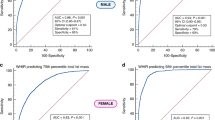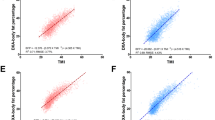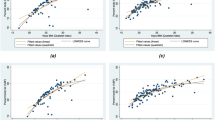Abstract
OBJECTIVE:
To evaluate the diagnostic accuracy of body mass index (BMI, kg/m2), waist-circumference (WC) and waist-hip-ratio (WHR) as diagnostic tests for detecting fatness in adolescents.
DESIGN:
A cross-sectional analysis of 474 healthy adolescents aged 17 y was used. Measurements of height, weight, WC, hip-circumference and body fat percentage (%BF) were obtained. The diagnostic accuracy for detecting excess fatness was evaluated through receiver operating characteristics (ROC) analyses with %BF, measured by densitometry (air-displacement plethysmography), as reference test.
RESULTS:
BMI and WC showed strong positive correlation (r=0.68–0.73; P<0.0001) with %BF in both sexes, but the correlation was weaker for WHR (r=0.30–0.41; P<0.0001). For overweight and obesity in boys and obesity in girls, the area under the ROC curve was high (0.96–0.99) for BMI and WC. WHR was not significantly better than chance as diagnostic test for obesity in girls. For BMI and WC, highly sensitive and specific cutoffs for obesity could be derived, while larger trade-offs were needed for detecting overweight in girls. The cutoffs producing equal sensitivity and specificity were lower than the ones minimizing the absolute number of misclassifications. The latter approached internationally recommended reference values, but were still several units lower for BMI in girls and several centimeters lower for WC in boys.
CONCLUSION:
BMI and WC were found to perform well as diagnostic tests for fatness, while WHR was less useful. The discrepancies between cutoffs producing equal sensitivity and specificity, cutoffs minimizing the absolute number of misclassifications and internationally recommended reference values for overweight and obesity highlight the importance of specifying the characteristics of classification systems for different settings.
This is a preview of subscription content, access via your institution
Access options
Subscribe to this journal
Receive 12 print issues and online access
$259.00 per year
only $21.58 per issue
Buy this article
- Purchase on Springer Link
- Instant access to full article PDF
Prices may be subject to local taxes which are calculated during checkout


Similar content being viewed by others
References
Obesity: preventing and managing the global epidemic. Report of a WHO consultation. World Health Organ Tech Rep Ser 2000; 894: i–xii, 1–253.
Guillaume M . Defining obesity in childhood: current practice. Am J Clin Nutr 1999; 70: 126S–130S.
Guo SS, Roche AF, Chumlea WC, Gardner JD, Siervogel RM . The predictive value of childhood body mass index values for overweight at age 35 y. Am J Clin Nutr 1994; 59: 810–819.
Guo SS, Chumlea WC, Roche AF, Siervogel RM . Age- and maturity-related changes in body composition during adolescence into adulthood: the Fels Longitudinal Study. Int J Obes Relat Metab Disord 1997; 21: 1167–1175.
Must A, Jacques PF, Dallal GE, Bajema CJ, Dietz WH . Long-term morbidity and mortality of overweight adolescents. A follow-up of the Harvard Growth Study of 1922 to 1935. N Engl J Med 1992; 327: 1350–1355.
Mossberg HO . 40-year follow-up of overweight children. Lancet 1989; 2: 491–493.
Cole TJ, Bellizzi MC, Flegal KM, Dietz WH . Establishing a standard definition for child overweight and obesity worldwide: international survey. BMJ 2000; 320: 1240–1243.
Burniat W, Cole TJ, Lissau I, Poskitt E . Child and Adolescent Obesity. Cambridge University Press: Cambridge; 2002.
Bellizzi MC, Dietz WH . Workshop on childhood obesity: summary of the discussion. Am J Clin Nutr 1999; 70: 173S–175S.
Kuczmarski RJ, Ogden CL, Grummer-Strawn LM, Flegal KM, Guo SS, Wei R, Mei Z, Curtin LR, Roche AF, Johnson CL . CDC growth charts: United States. Adv Data 2000; 314: 1–27.
Must A, Dallal GE, Dietz WH . Reference data for obesity: 85th and 95th percentiles of body mass index (wt/ht2) and triceps skinfold thickness. Am J Clin Nutr 1991; 53: 839–846.
Sardinha LB, Going SB, Teixeira PJ, Lohman TG . Receiver operating characteristic analysis of body mass index, triceps skinfold thickness, and arm girth for obesity screening in children and adolescents. Am J Clin Nutr 1999; 70: 1090–1095.
Taylor RW, Jones IE, Williams SM, Goulding A . Evaluation of waist circumference, waist-to-hip ratio, and the conicity index as screening tools for high trunk fat mass, as measured by dual-energy X-ray absorptiometry, in children aged 3–19 y. Am J Clin Nutr 2000; 72: 490–495.
Mei Z, Grummer-Strawn LM, Pietrobelli A, Goulding A, Goran MI, Dietz WH . Validity of body mass index compared with other body-composition screening indexes for the assessment of body fatness in children and adolescents. Am J Clin Nutr 2002; 75: 978–985.
Ohlin A, Rossner S . Maternal body weight development after pregnancy. Int J Obes 1990; 14: 159–173.
Dempster P, Aitkens S . A new air displacement method for the determination of human body composition. Med Sci Sports Exerc 1995; 27: 1692–1697.
McCrory MA, Gomez TD, Bernauer EM, Mole PA . Evaluation of a new air displacement plethysmograph for measuring human body composition. Med Sci Sports Exerc 1995; 27: 1686–1691.
Siri WE . Body composition from fluid spaces and density: analysis of methods. 1961. Nutrition 1993; 9: 480–491 discussion 480, 492.
Fu WP, Lee HC, Ng CJ, Tay YK, Kau CY, Seow CJ, Siak JK, Hong CY . Screening for childhood obesity: international vs population-specific definitions. Which is more appropriate? Int J Obes Relat Metab Disord 2003; 27: 1121–1126.
Reilly JJ, Dorosty AR, Emmett PM . Identification of the obese child: adequacy of the body mass index for clinical practice and epidemiology. Int J Obes Relat Metab Disord 2000; 24: 1623–1627.
Lazarus R, Baur L, Webb K, Blyth F . Body mass index in screening for adiposity in children and adolescents: systematic evaluation using receiver operating characteristic curves. Am J Clin Nutr 1996; 63: 500–506.
Williams DP, Going SB, Lohman TG, Harsha DW, Srinivasan SR, Webber LS, Berenson GS . Body fatness and risk for elevated blood pressure, total cholesterol, and serum lipoprotein ratios in children and adolescents. Am J Public Health 1992; 82: 358–363.
Lohman TG . Applicability of body composition techniques and constants for children and youths. Exerc Sport Sci Rev 1986; 14: 325–357.
Burniat W, Cole TJ, Lissau I, Poskitt E . Child and Adolescent Obesity, 1st edn. Cambridge University Press: Cambridge; 2002.
Zweig MH, Campbell G . Receiver-operating characteristic (ROC) plots: a fundamental evaluation tool in clinical medicine. Clin Chem 1993; 39: 561–577.
Altman DG, Bland JM . Diagnostic tests 3: receiver operating characteristic plots. BMJ 1994; 309: 188.
Goran MI, Gower BA, Treuth M, Nagy TR . Prediction of intra-abdominal and subcutaneous abdominal adipose tissue in healthy pre-pubertal children. Int J Obes Relat Metab Disord 1998; 22: 549–558.
Neovius MG, Linne YM, Barkeling BS, Rossner SO . Sensitivity and specificity for fatness of classification systems for adolescent overweight. Am J Clin Nutr 2004; 80: 597–603.
Himes JH, Bouchard C . Validity of anthropometry in classifying youths as obese. Int J Obes 1989; 13: 183–193.
Fields DA, Goran MI, McCrory MA . Body-composition assessment via air-displacement plethysmography in adults and children: a review. Am J Clin Nutr 2002; 75: 453–467.
Acknowledgements
The data collection phase of this study was funded by the European Commission, Quality of Life and Management of Living Resources, Key action 1 ‘Food, nutrition and health’ programme as part of the project entitled ‘Dietary and genetic influences on susceptibility or resistance to weight gain on a high fat diet’ (QLK1-2000-00515). The analysis phase was funded by Arbetsmarknadens Forsakrings-och Aktiebolag (AFA). Special thanks to Catharina Grimming, Eva Hedlund, Maria Saxer and Karin Vagstrand for the help and support in the data collection. Special thanks also to Professor James Stubbs of the Rowett Institute for comments, and to the unit for Preventive Nutrition, Karolinska Institutet, for access to the BodPod® equipment.
Author information
Authors and Affiliations
Corresponding author
Rights and permissions
About this article
Cite this article
Neovius, M., Linné, Y. & Rossner, S. BMI, waist-circumference and waist-hip-ratio as diagnostic tests for fatness in adolescents. Int J Obes 29, 163–169 (2005). https://doi.org/10.1038/sj.ijo.0802867
Received:
Revised:
Accepted:
Published:
Issue Date:
DOI: https://doi.org/10.1038/sj.ijo.0802867
Keywords
This article is cited by
-
Age-appropriate BMI cut-points for cardiometabolic health risk: a cross-sectional analysis of the Canadian Longitudinal Study on Aging
International Journal of Obesity (2022)
-
The effect of obesity on periodontitis progression: the 10-year retrospective cohort study
Clinical Oral Investigations (2022)
-
Impact of BMI on peak growth hormone responses to provocative tests and therapeutic outcome in children with growth hormone deficiency
Scientific Reports (2019)
-
Contingent sounds change the mental representation of one’s finger length
Scientific Reports (2017)
-
The effect of a physical activity consultation on body mass index z-score of overweight adolescents: results from a pediatric outpatient obesity clinic
European Journal of Pediatrics (2017)



